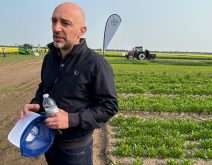Canadian officials have identified and located 23 cattle that potentially ate the same feed as a British Columbia dairy cow that was diagnosed with BSE in April.
It was Canada’s fifth case of BSE and the first in British Columbia. Canadian Food Inspection Agency officials continue to trace other animals that may also have been exposed to the same feed as the six-year-old cow.
A number of the animals exposed to the same feed as the cow are known to have been exported to the United States, said the agency in a BSE bulletin.
Read Also

Ag in Motion speaker highlights need for biosecurity on cattle operations
Ag in Motion highlights need for biosecurity on cattle farms. Government of Saskatchewan provides checklist on what you can do to make your cattle operation more biosecure.
Exported animals were also identified during BSE investigations in 2003 and 2005. They had been shipped before the border was closed after Canada’s first case of BSE was discovered in a northern Alberta cow in 2003.
CFIA officials say finding additional cases of BSE in animals that ate the same feed is unlikely because the infectious agent of BSE can be as small as a grain of sand.
The calves from the latest BSE cow are also being investigated. One is known to have died and officials are searching for the other.
As part of its investigation, the CFIA is examining ways the feed may have become contaminated during transportation and storage. Cattle are most susceptible to BSE during their early years of life.
The United States Department of Agriculture last week released its estimates of BSE prevalence in that country. Based on surveillance data, the government estimates it has four to seven animals with BSE, based on an adult cattle population of 42 million animals.
The estimate of BSE prevalence in the U.S. is based on data gathered from enhanced surveillance since June 2004 plus information from the previous five years. Samples were gathered from more than 5,000 locations including slaughterhouses, renderers, farms and diagnostic laboratories.
“We can now say, based on science, that the prevalence of BSE in the United States is extraordinarily low,” said agriculture secretary Mike Johanns.
















